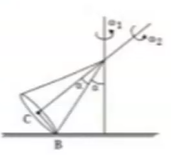Three identical square plates rotate about the axes shown in the figure in such a way that their kinetic energies are equal. Each of the rotation axis passes through the centre of the square. Then, the ratio of angular speeds is

The correct Answer is:A
We know that,
Topper's Solved these Questions
- ROTATIONAL MOTION'Book:MHTCET PREVIOUS YEAR PAPERS AND PRACTICE PAPERSChapter:ROTATIONAL MOTION'Exercise:MHT CET Corner
Explore 35 Videos
- ROTATIONAL MOTION'Book:MHTCET PREVIOUS YEAR PAPERS AND PRACTICE PAPERSChapter:ROTATIONAL MOTION'Exercise:PRACTICE EXERCISE (Exercise 1 (TOPICAL PROBLEMS))
Explore 70 Videos
- REFRACTION OF LIGHTBook:MHTCET PREVIOUS YEAR PAPERS AND PRACTICE PAPERSChapter:REFRACTION OF LIGHTExercise:Exercise 2
Explore 25 Videos
- SCALARS AND VECTORS Book:MHTCET PREVIOUS YEAR PAPERS AND PRACTICE PAPERSChapter:SCALARS AND VECTORS Exercise:Exercise 2 (Miscellaneous Problems)
Explore 20 Videos
Similar Questions
A solid square plate is spun around different axes with the same angular speed. In which of the following choice of axis of rotation will the kinetic energy of the plate be the largest?
View SolutionA solid sphere of radius r and mass m rotates about an axis passing through its centre with angular velocity ω. Its K.E. Is
View Solution
Knowledge Check
A solid cylinder of mass M and radius R rotates about its axis with angular speed ω. Its rotational kinetic energy is
A12MR2ω2BMR2ω2C14MR2ω2D18MR2ω2A solid cylinder of mass M and radius R rotates about its axis with angular speed ω. Its rotational kinetic energy is
A12MR2ω2BMR2ω2C14MR2ω2D18MR2ω2
Two identical discs are positioned on a vertical axis as shown in the figure. The bottom disc is rotating at angular velocity ω0 and has rotational kinetic energy K0. Change in the rotational kinetic energy of the system isAK0/2B−K0/2C−K0/4DK0/4
A solid sphere of radius r and mass m rotates about an axis passing through its centre with angular velocity ω. Its K.E. Is
View SolutionTwo discs of moments of inertia I1andI2 about their respective axes (normal to the disc and passing through the centre), and rotating with angular speed ω1andω2 are brought into contact face to face with their axes of rotation coincident . What is the angular speed of the two-disc system ?
View SolutionA conducting rod PQ is rotated in a magnetic field B about an axis passing through point O as shown in figure. Then potential difference between P&Q is (ω : angular speed)
View SolutionTwo discs of moments of inertia I1andI2 about their respective axes (normal to the disc and passing through the centre), and rotating with angular speed ω1andω2 are brought into contact face to face with their axes of rotation coincident (i) What is the angular speed of the two-disc system ? (ii) Show that the kinetic energy of the combined system is less than the sum of the initial kinetic energies of the two discs. How do you account for this loss in energy ? Take ω1≠ω2.
View SolutionA uniform solid cone (height h=4m,α=30∘) is inclined agains a vertical axis as shown in the figure. The cone rotates about its own axis as well as rotates about the vertical axis with angular speeds marked in the diagram. If the cone does not slip at point B,find ω1ω2

View Solution
